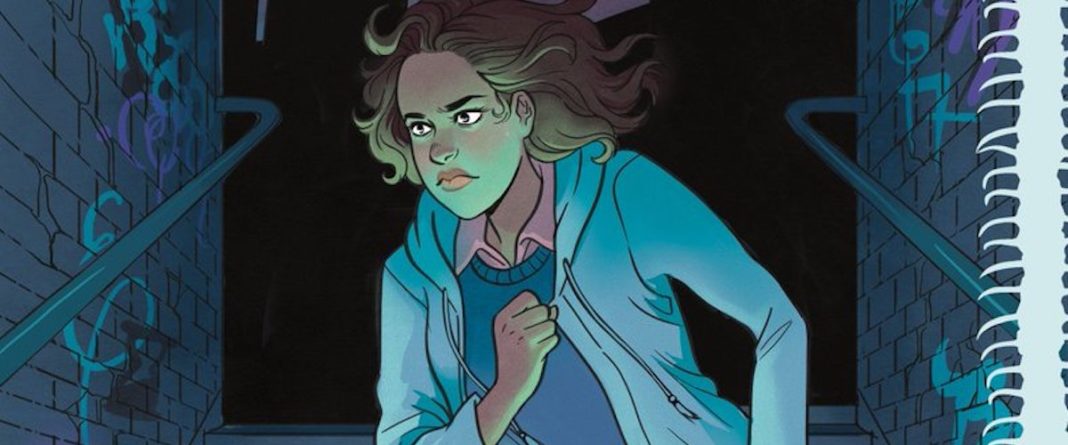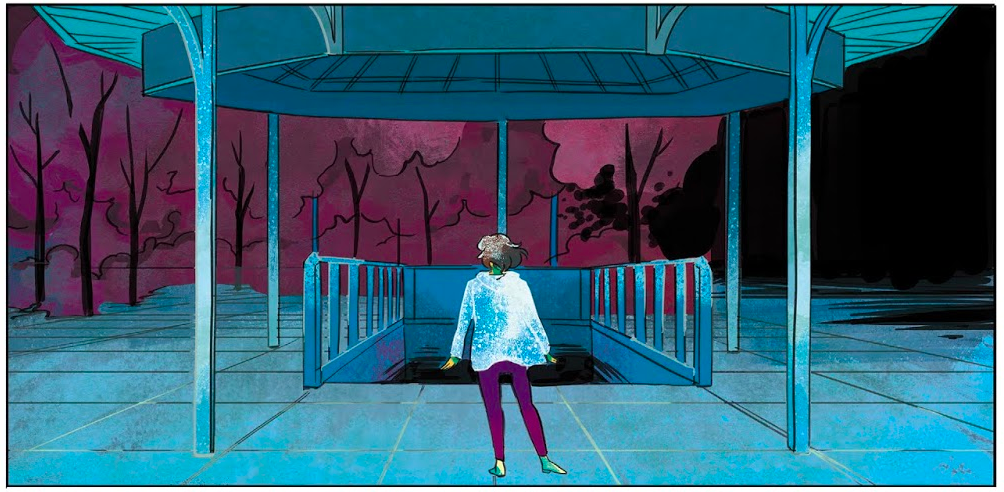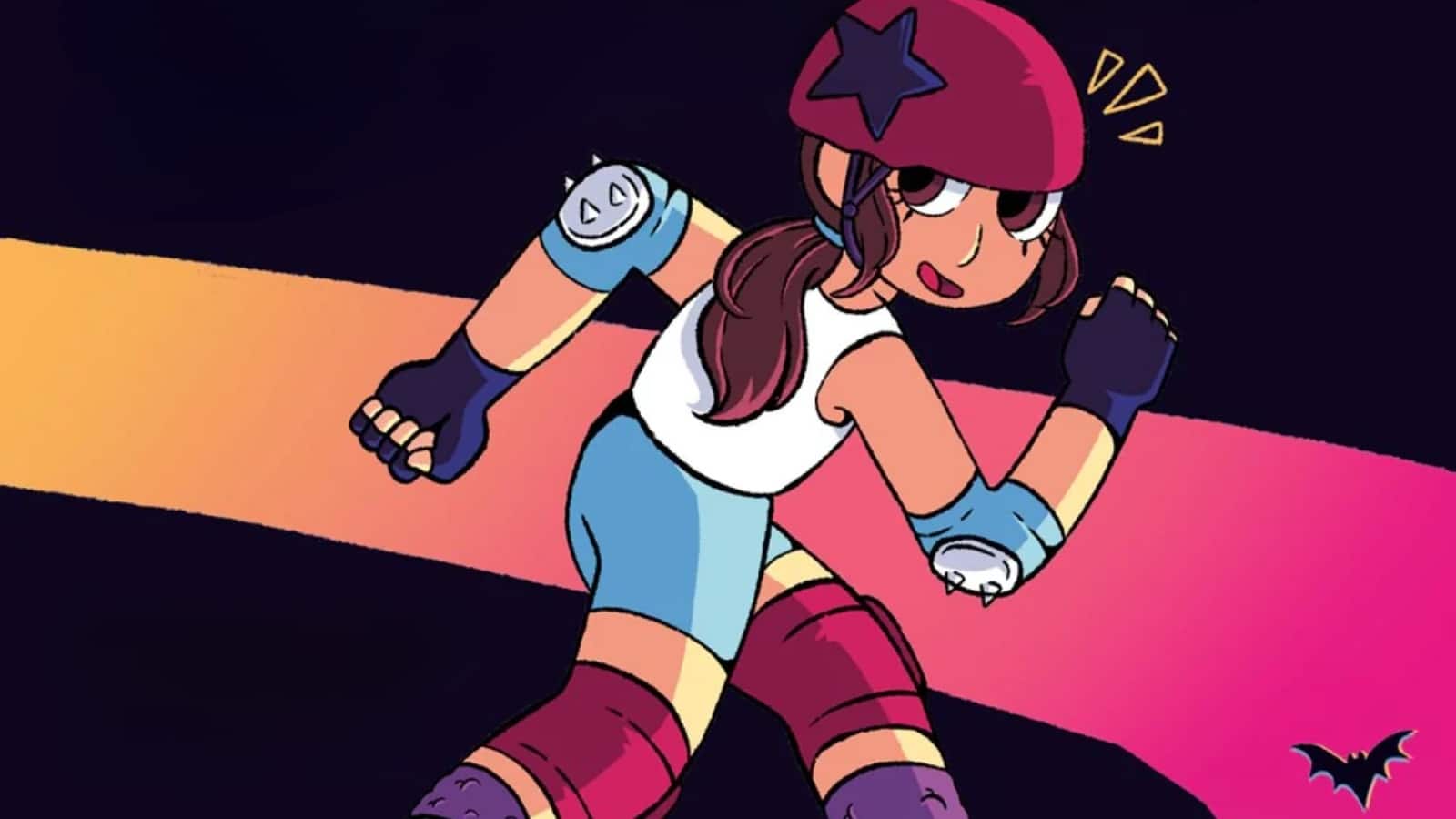Welcome to Queerness In Comics, a new bi-weekly column by Avery Kaplan, which will explore queer representation in comics. This week, Avery is exploring Submerged, a four-issue mini-series published in 2018.
Writer: Vita Ayala
Artist: Lisa Sterle
Colorist: Stelladia
Letterer: Rachel Deering
Publisher: Vault Comics
Myth and reality collide in Submerged, written by Vita Ayala, who is non-binary, with illustrations by Lisa Sterle, who is bi, and colors by Stelladia, who is genderqueer. In the four-issue mini-series, Elysia Puente spends the biggest hurricane in history in the flooding subways of New York City as she attempts to rescue her younger brother Angel from peril.
The surreal narrative mines mythological and literary illusions and pairs them with crime story archetypes to tell a personal narrative about Elysia’s struggle to release herself from the shackles that threaten to indefinitely imprison her beneath the surface of the city as the water level continues to rise.
My Brother’s Keeper
Ellie’s relationship with her brother is complicated. In the first issue, flashbacks to her childhood demonstrate how she was expected to bear responsibility for his actions: she was blamed when he ate a cake as a baby, and again when he “gets into trouble” at age 11. In both cases their mother assigns the responsibility to Ellie (first because he’s a baby, then because he’s a boy).
In a third flashback panel, an older Angel replicates the behavior, blaming Ellie because he drank too much and crashed a car. Ellie protests that she hadn’t even been with him, but Angel nevertheless assigns her responsibility for his actions, telling her that she knew he was going drinking, and she knows how he gets when he drinks. Whether he realizes it or not, Angel replicates the pattern of behavior instilled in him by watching their mother assign Ellie blame for his actions since infancy.
When her brother leaves a voicemail pleading for her help on the night of the largest hurricane in history, the sense of responsibility Ellie continues to feel for him drives her into the night. When she finds his broken cell phone at what appears to be the entrance to a subway, she heads down into the station in pursuit of her brother.
Classical Foundation
While Submerged is seemingly set in modern-day New York City — the characters use smart phones and the subways no longer accept tokens — the line between reality and mythology is blurred early on. Upon entering the subway station, Ellie meets three old men and a dog. Each of them represents a figure from Greek mythology: the men are the three judges who guard the entrance of the Underworld, and a three-headed shadow confirms that the dog is Cerberus.
Ellie does not recognize the mythical figures that guard the entrance of the Underworld, nor does she comprehend the classical references to the fact that while her brother had arrived at the land of the dead on time, Ellie had arrived early. Nevertheless, they accept her plea to follow her brother, providing her with three coins and directing her toward Charon and the ferry — embodied here by a conductor and subway train, respectively.
To Thine Own Self Be True
Ellie soon encounters a mysterious woman who speaks primarily in Shakespearian quotation. In quick succession, the “stranger” recites lines from Hamlet, All’s Well That Ends Well, and several other plays and poems by the Bard. Like the mythological figures that guard the entrance of the subway station, Submerged does not provide the source for the woman’s quotations, nor is it suggested that Ellie recognizes from where these lines are taken.
But even though the source may be obscure, the stranger’s words still mean something to Ellie in her current situation. According to the stranger, Ellie has a choice of doors. Behind one lies death — the “bitter truth,” that her brother is no longer among the living — and behind the other door, there is the “sweet lie.” While Ellie can’t decide which of the two doors to choose, an arm reaches out from the open door and pulls her through.
Family Chains
Behind the door, Ellie is forced to confront a vision of her mother. However, myth and reality have begun to blur here, too: she is presented as a ghastly figure that cries tears of blood and is encased in literal shackles.
As Ellie flees from the spectral vision, the chains extend to entrap her, and she is pulled into her mother’s waiting arms. As her mother insists that she loves her and pleads for forgiveness, the literal chains give way to metaphorical ones: flashbacks survey several incidents throughout Ellie’s life in which her mother first threatened or attacked her and then immediately began to beg for forgiveness.
These grounded examples of controlling behavior run parallel to Ellie’s fantastic experiences with the spectral vision of her mother in the subway: first attacking her with chains, then smothering her while demanding she be granted forgiveness for her abusive actions.
Words on Subway Cars
In the third issue, the relationship certain words have with underlying personal experiences is embodied by a series of subway cars. Peering into the windows of these cars, Ellie can see scenes of memories from her life playing out: meanwhile, each car has been tagged with words that relate to the memories encased within.
A car tagged with the phrases “you did this” and “your fault” contains Ellie’s memory of turning down her brother’s desperate phone call on the night of his death. As Ellie explores the cars further, the way different words connect to each other — along with the underlying connection of the memories within them — is dramatized by the connected subway cars.
Connections Beneath the Surface
In one car, Ellie sees a memory of a fight between herself and her brother over whether or not they will go to their father over the other sibling’s misdeeds. In order to gain leverage, Angel brings up the fact that he saw Ellie kissing a girl. This immediately causes Ellie to go on the defensive, worrying aloud that their father is home and might overhear. This gives Angel control over the situation, and he switches tactics, assuaging Ellie’s fears by saying she’s her father’s “princesa.”
The way this nickname connects to the Puente family history is dramatized by the next subway car over, which contains an early childhood memory: Ellie’s father gives her a lollipop and calls her “la princesa.” There are deep meanings under the words Angel used to exert control over the situation in the flashback, and memories within the subway cars demonstrate how the underlying meanings connect in ways that may not be obvious from the surface.
Trapped by a Word
As Ellie continues her journey into the underworld in pursuit of her brother, she also continues deeper through the graffiti-covered subway cars. Eventually, she enters one tagged “dyke.” Inside, she witnesses a memory of a younger version of herself confronting Angel over a pack of cigarettes. When she threatens to tell their father about his smoking, Angel declares that he will retaliate by revealing that she is a “dyke.”
Once again, Angel has gained control over the situation and forced Ellie into silence by using words, and in the next subway car, Ellie witnesses another memory of a confrontation with her brother. Angel reveals that he murdered someone in order to “protect the family.” The reason these cars are connected is significant – in both cases, her brother has forced her into silence by coercion through words.
Breaking the Chains
In the climactic scene in issue four, Ellie is bound by chains and forced to confront not only the spectral version of her mother again, but a spectral vision of her father, as well. By confronting the issues she has with her mother and father, Ellie is able to escape the chains that bind her – literally and metaphorically. This allows her to forgive herself for not being able to protect her brother from his fate, which releases Angel from imprisonment in a cage that has been serving as a throne for their spectral father.
The brother and sister flee from the throne room through the sewers, which are flooding from the storm, eventually returning to the cavern filled with subway cars. As they pass one of the cars with a memory of a fight between the siblings, Angel pulls his sister along, telling her that they have to “let that go.” The fact that the falling water has washed away the words on the sides of the subway cars is significant: it demonstrates that the memories contained within the cars have been divorced from the words, and as Angel says to Ellie, they are able to leave those memories behind.
Rebirth
Angel and Ellie successfully reach the exit, but while they are able to share the hopeful vision of dawn over New York City together, the late Angel must remain in the underworld. Ellie rows herself across the Hudson in the sunlight – the inversion of the subway ferry ride she took to enter the land of the dead. But while she could not rescue her late brother from his fate, her journey to the underworld has allowed her to free herself from the chains by which her family had bound her – including from the negative associations that were connected to certain words, like those that had tagged the subway cars.
This rebirth is demonstrated when she testifies against her father in court. After speaking out against his crimes, Ellie enters the witness protection program and can begin a sort of literal new life, presumably under a new name. The final panel of the book quotes the opening lines of The Odyssey, signifying that this is not the end of the hero’s journey, but the beginning of a new adventure.
The fact that the translation quoted is Emily R. Wilson’s 2018 translation of Homer’s text is meaningful, as well. By using a fresh translation, the familiar opening lines of Odysseus’s most famous journey are rendered new. Submerged draws on familiar myths and touchstones in a similar way to tell a story of a queer hero’s rebirth after being freed from the words to which she had been shackled, allowing her to emerge renewed and author her own adventure.












